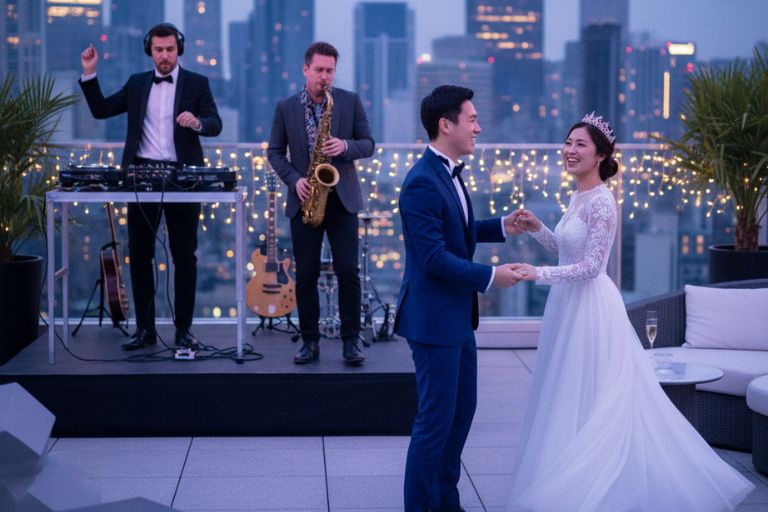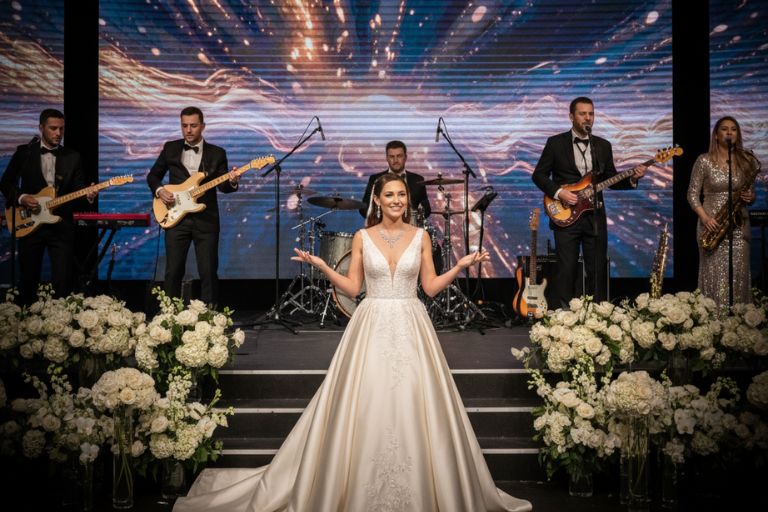You’ve spent thousands on entertainment, your first dance ends, the DJ announces “the dance floor is now open”—and nobody moves. Guests stay glued to their seats, making polite conversation while your carefully planned celebration flatlines.
This fear is universal among couples, but here’s the truth: empty dance floors aren’t random bad luck. They’re the predictable result of not understanding the psychology behind how people decide to dance. After 35+ years watching thousands of wedding receptions, I can tell you exactly how to get guests dancing at weddings—and keep them there all night.
The Science of Dance Floor Momentum
Dance floors operate on social physics. The hardest moment isn’t maintaining energy—it’s overcoming the initial inertia. Understanding this principle transforms how you approach your entire wedding entertainment strategy.
Critical Mass Theory: The 20-30% Rule
Research on group behavior shows that when 20–30% of people participate, momentum becomes self-sustaining. At a 150-guest wedding, you need about 30–40 people dancing before the floor feels irresistible.
Before that tipping point, standing up to dance feels risky; after it, staying seated feels like missing out. Every decision you make—from music to layout—should focus on reaching that critical mass quickly.
The entire strategy for how to get guests dancing at weddings revolves around engineering this tipping point as quickly as possible.

Strategy 1: Prime Your Inner Circle
Your bridal party and close friends are your dance floor ignition team. Brief them beforehand:
“When the first dance ends, hit the floor immediately and stay for at least three songs. You’re helping us get the party started.”
This transforms passive support into purposeful action.
Example: Emma and James from Melbourne told their 12-person bridal party their job was “dance floor activation.” Within 90 seconds of opening, 30 more guests joined—and the floor stayed full for three hours.
Strategy 2: Strategic Song Selection (The 80/20 Rule)
Professional entertainers rely on an 80/20 ratio: 80% familiar crowd-pleasers, 20% surprises—a proven formula for how to get guests dancing at weddings and keeping the energy alive all night.
The 80%: Proven Dance Floor Fillers
Timeless hits that bridge generations:
- September – Earth, Wind & Fire
- I Wanna Dance with Somebody – Whitney Houston
- Uptown Funk – Mark Ronson & Bruno Mars
- Dancing Queen – ABBA
- Don’t Stop Believin’ – Journey
These work because everyone knows them—shared familiarity removes self-consciousness and invites participation.
The 20%: Keep It Interesting
Once momentum builds, sprinkle in:
- Current chart-toppers for younger guests
- Genre twists (Latin, R&B, or country)
- Songs with personal meaning to you
Play your “interesting” songs after the dance floor is established—not before.
Strategy 3: Avoid the Dead Zone
The biggest dance floor killer? A slow ballad too early.
The typical mistake: First dance → upbeat opener → slow romantic song. Everyone sits down, and momentum dies.
Fix: Your first 4–5 songs must sustain high energy. Slow songs belong later—45+ minutes in—when people want a breather.
Add a note to your run sheet:
- Song 1: Post-first dance, high energy
- Song 2: Maintain energy
- Song 3: Peak crowd-pleaser
- Song 4: Sustain momentum

Strategy 4: Timing Is Everything
Dance floor energy follows a predictable rhythm. Plan your reception around it:
- 6:00–7:15 pm: Cocktails and mingling
- 7:15–8:00 pm: Dinner and speeches
- 8:00–8:15 pm: First and parent dances
- 8:15–9:00 pm: Critical window—launch dancing here
- 9:00–10:30 pm: Peak energy and biggest hits
- 10:30–11:00 pm: Wind down, final dance moments
Use that first 45 minutes after your first dance to hit critical mass.
Strategy 5: The Role of Lighting
Any strategy on how to get guests dancing at weddings must include the lighting setup. Lighting has a powerful psychological effect. Bright white light makes people self-conscious; dim, colorful light makes them feel relaxed and uninhibited.
Minimum requirements:
- Dim ambient light for dining
- Colored uplighting or moving lights on the dance floor
- No harsh overhead lighting once dancing starts
One Sydney bride told me: “As soon as the colored lights came on, everyone rushed to dance. It completely transformed the vibe.”
Strategy 6: Layout Matters
Your physical environment shapes behavior more than couples realize.
Optimal layout principles:
- Clear path to the dance floor—no obstacles
- Central placement so it’s the room’s focus
- Limited seating nearby to prevent spectating
- Visible from every table so guests feel included
Strategy 7: The Snowball Effect
Once momentum starts, your job shifts to protecting it. This means: Minimize Interruptions
What kills momentum:
- Stopping music for extended photo sessions during peak dancing
- Lengthy speeches when energy is high (save them for earlier)
- Clearing the floor for every special dance
Better approach: Do father-daughter and mother-son dances early (immediately after the first dance) rather than interrupting established dance floor momentum 45 minutes later.
Manage Announcements Strategically
Your MC should read the room. If the floor is packed and energy is at its peak, don’t interrupt for cake cutting. Wait for a natural lull or do it during a pre-planned break between sets.
Strategy 8: Work With Your Entertainer
Your DJ or band or DJ with live musician (sax or guitarist) can only execute the vision if they understand your priorities. In your planning meetings:
- Tell them explicitly: “Our biggest priority is a packed dance floor. We’re counting on you to build and maintain energy. Please front-load proven crowd-pleasers and don’t slow things down until momentum is solid.”
- Give them permission: “If a song isn’t working—even if it’s on our must-play list—feel free to cut it short and pivot.”
- Discuss your crowd: “We have guests from 8 to 80. Here’s what we know about their musical tastes…”
- Ask the right questions early: Part of your initial list of questions to ask wedding your dj should cover how they handle different age groups and musical tastes, how extensive their music library is, and, crucially, how they “read the room” and adjust the playlist in real-time.
Professional entertainers appreciate couples who communicate clearly rather than assuming telepathic understanding.

Stop overpaying for wedding entertainment 🎶
Learn insider secrets to book smarter, save thousands, and keep your dance floor full all night.
🎶 Secrets to Booking the Best Wedding Entertainment reveals insider strategies from music industry veteran Jeremy LaBrooy — showing you how to book smarter, save money, and elevate your celebration.
What Actually Kills Dance Floors
Learn from others’ mistakes:
- Your wedding playlist shouldn’t be your personal Spotify favorites. It should reflect your guests’ preferences while incorporating your personality.
- Playing too many slow songs early kills momentum before it builds.
- If guests can’t hear music clearly or it’s uncomfortably loud, they won’t dance.
- Trying to force dancing too early rarely works. Respect the natural energy arc.
- Your run sheet says “Dancing: 8:15pm” but dinner ran late. Forcing it creates awkwardness. Adapt to reality.
Real Success Story
Sarah and David’s Wedding – 160 Guests
They implemented every strategy:
- Briefed their 10-person bridal party on “dance floor activation duty”
- Worked with their band to front-load proven crowd-pleasers
- Invested in premium dance floor lighting ($550)
- Positioned the dance floor centrally with clear access
- Scheduled parent dances immediately after their first dance (not 45 minutes later)
Result: Critical mass achieved within 2 minutes of opening dancing. The floor stayed packed for 3.5 hours straight. Sarah later said: “We were terrified nobody would dance. Instead, guests complained their feet hurt from dancing so much. Best problem ever.”

Your Action Plan
Let’s now create an actual plan on how to get guests dancing at weddings;
8 weeks before wedding:
- Meet with entertainer to discuss crowd demographics and song strategy
- Confirm lighting package
- Review venue layout with coordinator
2 weeks before:
- Brief wedding party on their dance floor role
- Finalize song list using 80/20 principle
- Confirm timing with entertainer
Day of:
- Trust your entertainer to read the room
- Lead by example—stay on the dance floor
- Don’t stress if the first 2 minutes feel slow
Understanding how to get guests dancing at weddings isn’t about luck—it’s about applying proven psychological principles and strategic planning. Critical mass, strategic song selection, proper timing, and environmental optimization work together to create the celebration you’re envisioning.
For complete insider guidance on entertainment that transforms your celebration, grab “Secrets to Booking the Best Wedding Entertainment.”





